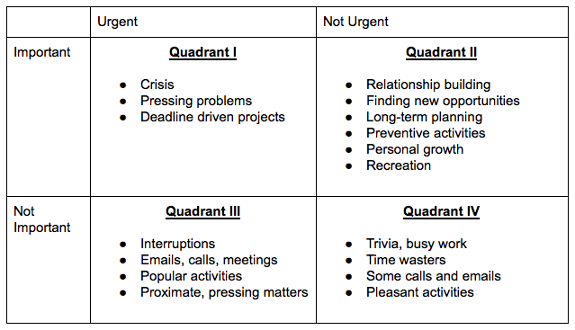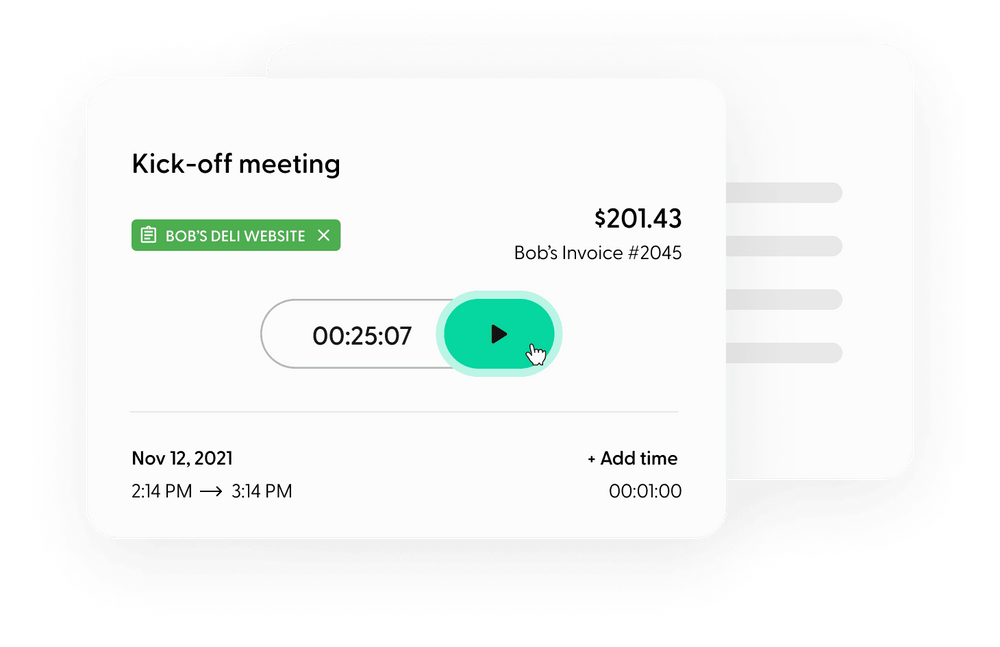In the age of the smartphone, where an endless stream of distractions awaits us menacingly in our pockets, managing our time is increasingly becoming more challenging. And there are a whole lot of time management techniques out there to make us more productive, but one stands out: The Covey Time Management Matrix by Stephen Covey.
This tool is particularly useful for better focusing our attention on the to-do list items that matter and ultimately increasing the long-term success of our businesses. Think prioritized list making, personal productivity, the seven habits of highly effective people, and managing all the most urgent things in our lives. Let's dive in.
What is the time management matrix?
The best way to familiarize yourself with Covey's Time Management Matrix is to take a look. Here's what the four quadrants of time management look like, built across two axes:
- Urgency: Urgent tasks that demand immediate attention
- Importance: Important tasks with significant value in relation to overall goals
The purpose of the Covey Time Management Matrix is to help you prioritize critical tasks, leading to proper time management. Let's run through the "Covey Four Quadrants."

Source: Facilethings
Quadrant 1: Important and urgent
These are the items that are likely causing you the most stress, and those that should be prioritized above all else. These are critical to achieving your goals (and your clients' goals!) and should be handled quickly and efficiently.
For quadrant 1 tasks, it's important you overcome poor planning by avoiding distractions and taking advantage of this Matrix strategy. Tasks that fall into Q1 share these qualities:
- Quickly approaching deadlines
- Related to meeting time-sensitive goals
- Related to eliminating risk
Quadrant 2: Important but not urgent
Q2 lacks the urgency that we see in Q1, but these tasks are just as important. To sum it up, they are important but not urgent. Because they don't involve impending deadlines and don't require immediate action, you have the freedom to breathe and take your time in figuring out how to perform these tasks effectively.
Therefore, you can increase productivity levels. Q2 items might:
- Need planning but not take too much time, requiring short-term focus
- Be an important piece of overall long-term goals and important activities
Quadrant 3: Not important but urgent
These aren't your most important or urgent items, but they are time-sensitive. These tasks can really throw our schedules and priorities out of alignment because we tend to confuse urgency with importance.
Let's say you get a work call while having dinner with your parents. Family is the important thing here and often you have limited time with them in your life, but you sacrificed that time to dive back into work when the call could have waited and was not urgent. This is where you need to learn to manage time and focus. Some Q3 items might be:
- Emails
- Calls
- Other minimally significant interruptions
These smaller tasks can pile on quickly and bog down your schedule, so it's important to push them to the side as you focus on quadrant 1 and 2 tasks first.
Quadrant 4: Not important and not urgent
When it comes to effective time management, it's highly important to know what falls in Q4, because these items are the items you should not be wasting your time on. They are often not urgent or important. Classify them as low priority and ensure you tackle quadrants 1, 2, and 3 first. There are a million things that could land in Q4, but here are some common qualities:
- Not directly related to goals and/or a task
- Not super stressful
- Contribute to time-wasting and take up more time
These four quadrants of time management make it easier to balance multiple tasks and keep moving forward.
How to place tasks in the time management matrix
Now that you know about the four quadrants of the time management matrix, it begs the question, "How do I know which tasks should be considered important or not?"
After all, putting the right tasks in the right quadrants is critical to making the most out of this productivity-boosting strategy.
It's safe to say that you should always prioritize the biggest tasks you need to accomplish to meet deadlines. But the many little tasks along the way always threaten to throw a wrench in the productivity wheel.
Here are three easy steps to organizing the Covey Matrix:
Step 1: Jot down all your tasks
First, you can write down all of the tasks you have along with their deadlines. This gives you a birds-eye view of everything that needs to get done and when.
Step 2: Analyze each item on the list
Next, analyze the list of tasks and determine what needs to be finished by the end of the day and what can wait until tomorrow.
Using a task management tool gives you a quick view of the tasks you need to accomplish. Plus, you can rearrange the order of tasks with drag-and-drop ease. Indy has a free task management tool to help you put the Covey Matrix into action.
Step 3: Start organizing the Covey Matrix
Now it's time to place the tasks into the four quadrants model. It may take a bit of time to assess which tasks are truly important, especially when every task seems major at the moment. But once you're finished, you'll have a better understanding of the urgent tasks going forward, and this process of labeling tasks within quadrants will get easier as you do it.
But what's the point of doing this? Here are some of the major benefits of using Covey's time management matrix to organize your to-dos.
Benefits of following the Covey Time Management Matrix
Productivity is crucial in the workforce, but it can also be challenging having to balance multiple tasks. Following a well-established framework for getting things done makes it easier to handle urgent matters.
Here are some other huge benefits of the time management matrix:
- Relieves stress: Juggling multiple projects can be stressful, but following these four quadrants takes the pressure off needing to get everything done at once.
- Increases productivity: By assigning tasks to the right quadrants, you'll always know the order in which assignments need to be accomplished.
- Creates a better work-life balance: Prioritizing tasks helps you get things done faster so you'll have more time to spend with family and friends or take a relaxing break.
- Accomplishes long-term goals: Everyone has goals in life. And it's tough to plan ahead and execute those long-term goals when you're too busy trying to get short-term assignments done. With better time management, you'll have the time and energy to think about the future.
4 Bonus personal productivity tips
Since productivity is such an important topic, we have some bonus tips to help you crush your time management goals. Here are some productivity tips that you can use alongside the Covey Matrix. Let's dive in!
1. Group similar tasks together
When working through your to-do list, it's best to work on tasks that are similar in nature. It takes the brain time to readjust when moving on to a different task, so you can increase productivity by focusing on similar tasks that keep you "in the zone."
2. Stop multitasking
This may seem counterintuitive when you're trying to get a lot of assignments done, but studies have shown that multitasking doesn't help. We're just not equipped to process two dissimilar tasks at once, causing our brain to have to split its focus. For efficiency, it's better to stay focused on one task until it's complete.
3. Take breaks
It's hard to want to take breaks when you have a lot to get done, but taking brief breaks after finishing assignments gives your mind a chance to recharge for the next task.
4. Get rid of distractions
Take a look around at any distractions that might be causing roadblocks in your process. Is your environment too noisy? If so, you might need to change locations.
Or maybe the faint ringing sound of silence is too distracting? In that case, you might get more work done when listening to relaxing music. Find the best environment for you and your productivity will get a boost.
Wrapping up
Covey's Time Management Matrix might not be your be-all and end-all. And it doesn't have to be. What's important is finding a technique that helps you use your time spent and become more productive to reach your business and personal goals.
It can even help in your private life with managing those important things and all those activities including family. I'm a fan of the matrix because it's an objective-like helping hand when it comes to productivity, personal development, and time management strategies. But habits of highly successful people vary.
If you're struggling with productivity, prioritizing tasks, and managing urgent things in your life and are unsure of what to do, give it a try!
It just might be the game-changer you've needed to help establish a better work-life balance for the long run. Spend less time on the less important things in your life and more time on the more important things to help you grow in your personal life.




